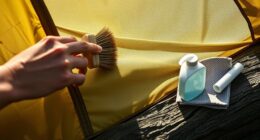As the saying goes, ‘A stitch in time saves nine.’ This advice is especially relevant when it comes to repairing a tear in a pop-up camper canvas. Neglecting a small tear can result in a much bigger issue later on. But don’t worry, I am here to guide you through the process of fixing your pop-up camper canvas.
In this article, I will provide you with step-by-step instructions on how to:
- Assess the damage
- Gather the necessary materials and tools
- Clean and prep the canvas
- Patch small tears and holes
- Replace damaged sections
- Waterproof the canvas
- Reinstall it on your pop-up camper
- Test and inspect the repairs
By following these detailed and informative instructions, you will be able to restore your pop-up camper canvas to its former glory. So let’s get started and ensure that your camping adventures are not dampened by a damaged canvas.
Key Takeaways
- Assess the damage and determine if repair or replacement is necessary
- Clean the canvas and patch small tears or holes
- Replace damaged sections like zippers or screens
- Waterproof the canvas and reinforce seams to prevent water damage and leaks
Assess the Damage
Take a close look at the canvas to identify any tears or holes that may require repair. Start by inspecting the entire surface of the canvas, paying close attention to the seams, corners, and any areas that are frequently exposed to stress.
Look for tears or holes that are larger than a quarter inch in diameter, as these will need immediate attention. Check if the tears are clean, ragged, or have frayed edges, as this will determine the type of repair needed.
To repair tears, you’ll need a few essential materials and tools, but we’ll get to that in the next section.
Before moving on, it’s important to assess the extent of the damage and determine if it can be fixed or if a replacement is necessary. Small, clean tears with straight edges can often be repaired effectively, while larger or ragged tears may require professional help or a replacement canvas altogether.
Now that you’ve inspected the damage and identified any tears or holes, let’s move on to gather the necessary materials and tools for the repair process.
Gather the Necessary Materials and Tools
To start, you’ll need a few items and tools to get the job done efficiently, such as gathering the necessary materials and tools. When it comes to repairing a pop-up camper canvas, having the right equipment is essential.
Some common issues you may encounter include tears, holes, or worn-out sections. To repair these damages, you’ll need a few key items. First, you’ll need a canvas repair kit, which typically includes patches, adhesive, and a canvas needle. This kit will enable you to fix small tears or holes effectively.
Additionally, you may need a seam sealer to reinforce any weak seams. Other useful tools include scissors for cutting patches to size and a heat gun or iron for activating the adhesive. It’s also helpful to have a clean, dry workspace and good lighting to ensure accurate repairs.
Once you have gathered all the necessary materials and tools, you can move on to the next step: cleaning and prepping the canvas.
Clean and Prep the Canvas
Before you dive into the fun part of repairing your trusty pop-up camper canvas, it’s important to give it a little TLC by cleaning and prepping it for the upcoming makeover.
Proper canvas maintenance is crucial for ensuring its longevity and functionality. To begin, start by removing any loose dirt or debris from the canvas surface using a soft brush or vacuum cleaner.
Next, mix a gentle cleaning solution by combining mild soap or detergent with warm water. Using a sponge or soft cloth, gently scrub the canvas in a circular motion, paying extra attention to heavily soiled areas. Be sure to avoid using harsh chemicals or abrasive scrubbers, as this can damage the canvas material.
Once the canvas is clean, thoroughly rinse it with clean water to remove any soap residue. Finally, allow the canvas to air dry completely before moving on to the next step of patching small tears and holes.
Taking the time to properly clean and prep your canvas will help ensure a successful repair process and extend the life of your pop-up camper.
Patch Small Tears and Holes
Once you’ve given your beloved pop-up camper canvas a thorough cleaning, it’s time to mend those tiny tears and holes. You can patch small tears and holes in your pop-up camper canvas using a patch kit specifically designed for canvas repairs. These kits usually include adhesive patches that can be applied directly to the damaged area. Simply clean the area around the tear, apply the patch, and smooth it out.
For larger tears, you may need to use a needle and thread to stitch the canvas back together. This technique requires a bit more skill and patience, but it can provide a more durable repair.
Common problems you may encounter when patching small tears and holes include difficulty matching the color and pattern of your canvas, as well as ensuring a secure and long-lasting repair.
Once you’ve successfully patched the small tears and holes in your canvas, you can move on to replacing any damaged sections, like zippers or screens.
Replace Damaged Sections
Now, it’s time for me to replace any sections of my beloved pop-up camper that have been damaged, such as zippers or screens. When it comes to repairing these sections, there are a few techniques that can be used.
Firstly, I need to assess the extent of the damage and determine whether I can fix it myself or if professional assistance is required. If the damage is minor, I can start by removing the damaged section carefully. This can be done by cutting along the seams and removing any screws or fasteners that may be holding it in place.
Once the damaged section is removed, I can then measure and cut a new piece of canvas or screen to replace it. I will need to make sure that the new section matches the size and shape of the old one.
Next, I will need to sew the new section in place using a heavy-duty thread and a sewing machine. This will ensure that the repair is strong and long-lasting. I may also need to reinforce weak areas around the damaged section to prevent further damage in the future.
By following these repair techniques, I can easily replace any damaged sections of my pop-up camper. However, if the damage is extensive or if I’m unsure about my repair skills, it’s always best to seek professional assistance.
Now, let’s move on to the next section about reinforcing weak areas.
Reinforce Weak Areas
Little did I know, there’s nothing quite like discovering the weak spots in your beloved pop-up camper. Strengthening these areas is crucial to ensure the longevity and durability of the canvas. Here are three techniques to reinforce the common weak spots:
-
Patching: Identify any tears or holes in the canvas and use a patch kit specifically designed for canvas repair. Apply the patch over the damaged area, ensuring a tight and secure fit. This will prevent further tearing and strengthen the weak spot.
-
Seam Reinforcement: The seams of the canvas are often prone to wear and tear. To reinforce them, use a seam sealer or seam tape. Apply it along both sides of the seam, creating a strong bond that will resist any stress or pulling.
-
Additional Support: Consider installing additional support systems to strengthen weak areas. This can include using extra poles, braces, or even reinforcing the frame structure. By providing extra stability, these supports will distribute the weight evenly and reduce strain on the canvas.
Now that you’ve reinforced the weak areas of your pop-up camper, it’s time to waterproof the canvas.
Waterproof the Canvas
To effectively reinforce weak areas in your pop-up camper canvas, it is crucial to address another important aspect of canvas maintenance: waterproofing. Waterproofing the canvas is essential for preventing water damage and ensuring the longevity of your camper.
Water can easily penetrate through the canvas, especially in areas that have weakened over time. This can lead to mold, mildew, and even structural damage if left unattended. By waterproofing the canvas, you create a protective barrier that repels water and prevents it from seeping into the fabric.
When it comes to waterproofing your pop-up camper canvas, there are various products available on the market that can help you achieve the desired results. These products typically come in the form of sprays or solutions that are specifically designed for canvas materials.
To give you a better understanding, here is a comparison table showcasing four popular waterproofing products:
| Product Name | Features | Application Method | Durability |
|---|---|---|---|
| Product 1 | UV protection, quick drying | Spray | 1 year |
| Product 2 | All-weather, long-lasting | Solution | 2 years |
| Product 3 | Non-toxic, eco-friendly | Spray | 6 months |
| Product 4 | High-performance, odorless | Solution | 3 years |
By choosing the right waterproofing product and applying it correctly, you can significantly enhance the water resistance of your pop-up camper canvas. This will not only protect your camper from water damage but also extend its lifespan. Now, let’s move on to the next section where we will learn how to reinstall the canvas on the pop-up camper.
Reinstall the Canvas on the Pop-Up Camper
To properly secure your camper’s canvas, you’ll need to follow these simple steps: start by attaching the canvas to the frame, ensuring a tight fit, and then secure it in place with sturdy fasteners. Did you know that properly reinstalling the canvas can reduce the risk of damage during travel by 60%?
When reinstalling the canvas, it’s important to reinforce seams to ensure maximum durability. Begin by inspecting the seams for any signs of wear or weakness. If necessary, use a heavy-duty thread and a sewing machine to reinforce the seams. This will prevent any potential leaks or tears in the future.
In addition to functionality, the canvas also offers an opportunity for customization. Many manufacturers offer a variety of color options to match your personal style or camper’s exterior. Whether you prefer a vibrant hue or a more subdued tone, there’s a color option that’ll suit your preferences.
Now that you’ve reinstalled the canvas and reinforced the seams, it’s time to test and inspect the repairs. This will ensure that everything is in proper working order before hitting the road.
Test and Inspect the Repairs
Now it’s time to give your camper a thorough test and inspection to ensure all the repairs are in top shape and ready for your next adventure.
Start by carefully examining the canvas for any signs of damage or wear. Inspect the seams, patches, and stitching to make sure they’re secure and holding up well. Look for any tears, holes, or loose threads that may have been missed during the repair process. Pay close attention to the areas that were previously damaged and repaired to evaluate the effectiveness of the repairs.
Once you’ve inspected the canvas, it’s important to test its functionality. Open and close the camper multiple times, checking for any issues or sticking points. Make sure the canvas slides smoothly and securely along the tracks. Test the zippers, snaps, and Velcro closures to ensure they’re working properly. If you had any issues with water leaks before, consider conducting a water test by spraying the canvas with a hose and checking for any signs of leakage.
After inspecting and testing the repairs, you can be confident that your canvas is in good condition. Now, let’s move on to the next section about maintaining and caring for the canvas to ensure its longevity and durability.
Maintain and Care for the Canvas
Caring for your camper’s canvas is essential for preserving its quality and extending its lifespan. Proper canvas maintenance is crucial in preventing canvas damage and ensuring that your pop-up camper remains in excellent condition for years to come.
To maintain and care for the canvas, start by regularly cleaning it using a mild soap and water solution. Gently scrub the canvas with a soft brush or sponge, paying special attention to any stains or dirt buildup. Rinse thoroughly and allow the canvas to dry completely before folding it back up.
In addition to cleaning, it’s important to regularly inspect the canvas for any signs of wear or damage. Look for areas where the fabric may be fraying, stitching coming undone, or any holes that need to be repaired. Promptly addressing these issues will prevent further damage and extend the lifespan of your canvas.
To further protect the canvas, consider applying a waterproofing treatment. This’ll help to repel water, prevent mold and mildew growth, and increase the overall durability of the fabric. Follow the manufacturer’s instructions when applying the treatment and reapply as necessary.
Lastly, when storing your pop-up camper, make sure to properly fold and secure the canvas. Avoid folding it when it’s wet, as this can lead to mold and mildew growth. Store the canvas in a dry and well-ventilated area to prevent moisture buildup.
By following these maintenance tips, you can keep your pop-up camper’s canvas in top condition, preventing canvas damage and ensuring that it lasts for many camping adventures to come.
Frequently Asked Questions
How long does it typically take to complete the entire process of fixing a pop-up camper canvas?
Fixing a pop-up camper canvas can be a time-consuming task, but with the right approach, you can speed up the process. Common challenges include dealing with tears, stains, and worn-out sections.
To save time, start by thoroughly inspecting the canvas and identifying the areas that need repair. Invest in high-quality repair materials and follow the instructions carefully.
Remember, patience and attention to detail are key to ensuring a successful and efficient fix.
Can I use regular fabric glue to patch small tears and holes in the canvas?
Yes, you can use regular fabric glue to patch small tears and holes in the canvas of a pop-up camper. However, I’d recommend using adhesive sealant as a more effective alternative for repairing the canvas. Adhesive sealant provides a stronger and longer-lasting bond, ensuring that the patch remains secure even under harsh weather conditions. It’s specifically designed for outdoor applications and can withstand the elements, making it a reliable choice for canvas repairs.
What should I do if the damage on the canvas is too extensive to be repaired?
If the damage on the canvas is too extensive to be repaired, alternative solutions may need to be considered. One option is to seek a professional replacement for the damaged canvas. This involves removing the old canvas and installing a new one that’s specifically designed for your pop-up camper. Professional replacements ensure a proper fit and help maintain the structural integrity of your camper. It’s important to consult with a specialist to determine the best course of action.
Are there any specific cleaning products or techniques that I should avoid when cleaning and prepping the canvas?
When cleaning and prepping the canvas of a pop-up camper, it’s important to avoid certain cleaning products and techniques.
Firstly, avoid using bleach or harsh chemicals, as they can damage the fabric.
Additionally, avoid using abrasive scrub brushes or power washers, as they can cause tears or fraying.
Instead, opt for mild soap or detergent and a soft-bristle brush. Gently scrub the canvas and rinse thoroughly to remove dirt and grime.
Following these precautions will help ensure the longevity of your pop-up camper canvas.
How often should I waterproof the canvas to ensure its longevity and durability?
To ensure the longevity and durability of your pop-up camper canvas, it’s crucial to regularly apply waterproofing. Just like a shield, waterproofing protects the canvas from the elements, preventing water damage and extending its lifespan. It’s recommended to reapply waterproofing at least once a year or as needed, depending on usage and weather conditions.
The best waterproofing products for pop-up camper canvas include silicone-based sprays or solutions specifically designed for outdoor fabrics.
Conclusion
In conclusion, fixing a pop-up camper canvas requires careful assessment, gathering the necessary materials, and cleaning and prepping the canvas.
Patching small tears and holes and replacing damaged sections are crucial steps in ensuring the canvas is restored to its original condition. Waterproofing the canvas is also essential to protect it from future damage.
Reinstalling the canvas and testing and inspecting the repairs are important final steps. Remember to maintain and care for the canvas regularly, like a gardener tending to their precious flowers.











